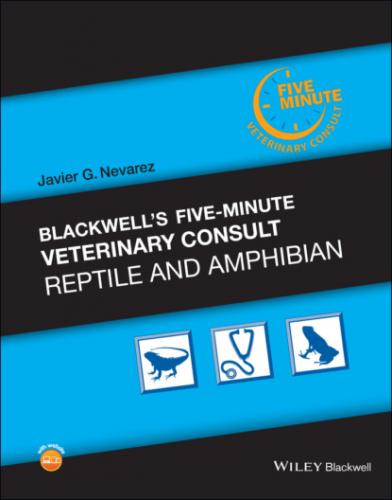DRUG(S) OF CHOICE
As most of these cases present in a chronic state, vision is often already lost, and medications are used to control pain and slow the disease process during diagnostic evaluation, but enucleation as a salvage procedure is usually indicated.
If acute glaucoma is suspected, it is important to start treatment immediately with topical β‐adrenergic blockers (such as timolol) and CAIs (such as dorzolamide) BID to TID and mannitol (1–2 g/kg IV slowly over 20–30 minutes) to reduce IOP and preserve vision.
If uveitis is suspected, systemic and topical antibiotics (such as ceftazadime 20 mg/kg IM or SC q48–72h) and steroids (prednisolone 0.25–0.5 mg/kg daily or dexamethasone SP 0.04–0.08 mg/kg daily) should also be instituted.
PRECAUTIONS/INTERACTIONS
N/A
PATIENT MONITORING
Serial IOP measurements are useful to determine response to therapy.
EXPECTED COURSE AND PROGNOSIS
Prognosis is related to the underlying cause of the glaucoma, which is not always readily identifiable.
Enucleation of the diseased globe will resolve the issue in most cases.
COMMENTS
N/A
ZOONOTIC POTENTIAL
Depends on the cause of the buphthalmos, but low to most often no zoonotic potential.
SYNONYMS
N/A
ABBREVIATIONS
CAI = carbonic anhydrase inhibitor
IOP = intraocular pressure
IV = intravenous
SC = subcutaneous
Suggested Reading
1 Chittick B, Harms C. Intraocular pressure of juvenile loggerhead sea turtles (Caretta caretta) held in different positions. Vet Rec 2001; 149(19):587–589.
2 Delgado C, Mans C, McLellan GJ, et al. Evaluation of rebound tonometry in red‐eared slider turtles (Trachemys scripta elegans). Vet Ophthalmol 2014; 17(4):261–267.
3 Espinheira Gomes F, Brandão J, Sumner J, et al. Survey of ophthalmic anterior segment findings and intraocular pressure in 95 North American box turtles (Terrapene spp.). Vet Ophthalmol 2016; 19(2):93–101.
4 Gornik KR, Pirie CG, Marrion RM, et al. Ophthalmic variables in rehabilitated juvenile Kemp’s ridley sea turtles (Lepidochelys kempii). J Am Vet Med Assoc 2016; 248(6):673–680.
5 Hochleithner C, Holland M. Ultrasonography. In: Mader, DR, Divers SJ, eds. Current Therapy in Reptile Medicine and Surgery. Saint Louis, MO: Elsevier Saunders; 2014:107–127.
6 Lawton, MPC. Reptilian Ophthalmology. In: Mader DR, ed. Reptile Medicine and Surgery. 2nd ed. St. Louis, MO: Elsevier Saunders; 2006:323–342.
7 Rajaei S, Ansari mood M, Sadjadi R, Azizi F. Measurement of intraocular pressure using Tonovet® in european pond turtle (Emys orbicularis). J Zoo Wildl Med 2015; 46(2):421–422.
8 Selleri P, Di Girolamo N, Andreani V, et al. Evaluation of intraocular pressure in conscious Hermann’s tortoises (Testudo hermanni) by means of rebound tonometry. Am J Vet Res 2012; 73(11):1807–1812.
9 Selmi AL, Mendes GM, MacManus C. Tonometry in adult yellow‐footed tortoises (Geochelone denticulata). Vet Ophthalmol 2003; 6(4):305–307.
10 Selmi AL, Mendes GM, MacManus C, Arrais P. Intraocular pressure determination in clinically normal red‐footed tortoise (Geochelone carbonaria). J Zoo Wildl Med 2002; 33(1):58–61.
11 Selmi AL, Mendes GM, MacManus C. Tonometry in adult yellow‐footed tortoises (Geochelone denticulata). Vet Ophthalmol 2003;6(4):305–307.
12 Somma AT, Lima L, Lange RR, et al. The eye of the red‐eared slider turtle: morphologic observations and reference values for selected ophthalmic diagnostic tests. Vet Ophthalmol 2015; 18(Suppl 1):61–70.
Author Christopher S. Hanley, DVM, DACZM
Cardiac Disease
DEFINITION/OVERVIEW
Cardiovascular disease encompasses a group of disorders of the heart and blood vessels including:
Cardiomyopathy
Septic endocarditis
Valvular insufficiency (with no current evidence of primary degenerative endocardiosis)
Myocarditis
Pericardial effusion
Infarct
Atherosclerosis
Aneurysm (rupture of aortic or carotid aneurysm)
Gout
Arterial calcification
Thrombus
Parasitic infestations
Congenital heart defects
Tumors
ETIOLOGY/PATHOPHYSIOLOGY
Infectious
Often secondary to systemic infections in captive reptiles.
Bacterial: aerobic Gram‐negative bacteria: Salmonella spp., Corynebacterium spp., Pseudomonas spp. (endocarditis). Flavobacterium spp. and Vibrio spp. in a Barber’s map turtle (Graptemys barbouri) (myocarditis).
Parasitic: Trematodes (spirorchid flukes: Spirorchis spp., Learedius spp.) have been reported in the heart chambers and major vessels of sea and freshwater turtles (Chelonia mydas, Trachemys scripta elegans, Chrysemys picta), causing arteritis, endocarditis, granulomatous myocarditis, thrombosis and aneurysm.
Non‐Infectious
Neoplastic (primary neoplasia is uncommon in reptiles): hemangioma, hemangiosarcoma, cardiac rhabdomyosarcoma, fibrosarcoma; disseminated coelomic papillomas affecting various organs, including the heart, are frequently found in sea turtles with fibropapillomatosis.
Metastasis to the heart: metastatic chondrosarcoma, metastasis of oviductal adenocarcinoma, disseminated mast cell tumor, multicentric lymphoblastic lymphoma and lymphoblastic malignant lymphoma.
Metabolic: visceral gout can cause urate crystals deposition in the pericardium.
